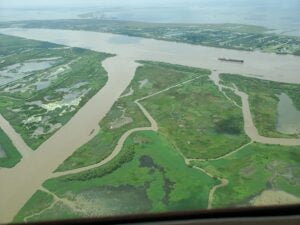What’s the Difference Between Neptune Pass and Mardi Gras Pass?
In the final miles of the Mississippi River, two naturally occurring diversions on the east bank of the Mississippi River provide vital real-world examples of the power of the river.
Their differences – and similarities – are instructive examples for the future of restoration projects along the river.Both Neptune Pass and Mardi Gras Pass are diversions on the east bank of the Mississippi River in Plaquemines Parish that formed naturally and continue to build land in their outfall areas.
The differences between the two natural diversions include the age of the pass forming, max flow capacity and location.
Mardi Gras Pass
In February of 2012, after the Mississippi River experienced a prolonged high-water event, the river officially broke through its eastern bank and created a new channel into Breton Sound. This channel became known as Mardi Gras Pass. In 2014, scientists first observed new land emerging, built by the continual deposition of sediment and fresh water, and over the last decade, that process has continued into Breton Sound. While new passes in the river can quickly expand, Mardi Gras Pass’ channel from the river remains virtually unchanged since 2019.
A new study done by Dr. Michael Hopkins, Science Program Director at Pontchartrain Conservancy, found that Mardi Gras Pass is stable, land is growing and the pass does not affect navigation on the river.
The mud flat created by sediment from Mardi Gras Pass is still building in American Bay, where species including river otters and bald eagles enjoy the new habitat. Vegetation, including black willows, is taking more of a hold – parts of the outfall area are transitioning from a marsh to a forest habitat due to the sediment and freshwater coming through the pass.
To learn more about the history of Mardi Gras Pass, watch the video below where our partners at Pontchartrain Conservancy (then Lake Pontchartrain Basin Foundation) studied the 2011 flood across the Bohemia Spillway to better understand the river.
Neptune Pass
Neptune Pass is a more recent development along the banks of the Mississippi River. Rapidly growing since 2019, Neptune Pass is a significantly larger outlet than Mardi Gras Pass, and it is building land and transforming the nearby ecosystem at a quicker pace than Mardi Gras Pass.
At the Mississippi River’s peak flow, Neptune Pass can flow at more than 100,000 cfs, which is more than three times the maximum output of Mardi Gras Pass. Due to its volume, Neptune needs to be managed for potential navigation concerns, while Mardi Gras Pass does not. The channel has been stabilized by the U.S. Army Corps due to its impact on river navigation, so those concerns have been addressed for the moment.
Dr. Alex Kolker, a leading coastal geologist at Louisiana Universities Marine Consortium recently authored a report on the effects of Neptune Pass, finding that “the system is functioning like the river diversions that are part of Louisiana’s coastal restoration strategies.”
The natural river diversion at Neptune Pass is much earlier in its deltaic life cycle than Mardi Gras Pass, but it is quickly spreading sediment across Quarantine Bay and Bay Denesse, where existing terracing projects are trapping the sediment and building new land This outfall area is quickly becoming a thriving haven for wildlife including ducks, alligators, redfish and more.
Measurements indicate that while some sediment being deposited in Quarantine Bay was from the scouring of the banks, a large portion of the material was coming from sediment carried by the Mississippi River. Dr. Kolker’s study indicates that more than 3 million tons of sediment from the river were deposited into Quarantine Bay.
Ongoing monitoring of Neptune Pass is underway, but the channel is stable, land is growing, and the pass does not affect navigation on the river.
A Tale of Two Banks
While Mardi Gras and Neptune Passes on the east bank are building thriving wetlands thanks to sediment from the Mississippi River, other areas along the river, especially on its west bank , are cut off from any sediment supply and are losing land rapidly. The uncontained influx of saltwater has caused rapid land loss on the river’s west bank, but in contrast, due to its connection with the river, the east bank is teeming with wildlife, new sandbars and even young willow forests.
To restore coastal Louisiana, we must reconnect the Mississippi River with its wetlands and use the sediment and fresh water from the river to build new land – just like Neptune and Mardi Gras Pass are doing. Louisiana’s keystone restoration project, the Mid-Barataria Sediment Diversion, uses the same process as these natural diversions and will build new wetlands in the Barataria Basin. To learn more about how this restoration project mimics nature, read The Mid-Barataria Sediment Diversion: Fact vs. Fiction.

